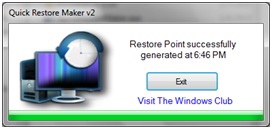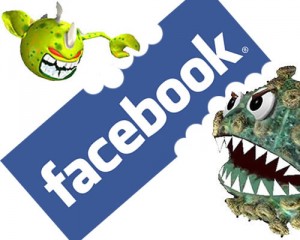Quick Restore Maker – Creating System Restore Points with the Quick Restore Maker
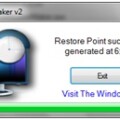
Welcome to Quick Restore Maker
If you ever managed to create a manual System Restore point, you know it takes about 7 clicks to do so, because the path to the shortcut is several levels deep, and most people don’t even know how to browse to it. If you do, then you are really going to appreciate this tool called “Quick Restore Maker” from a forum member in The Windows Club (TWC) nicknamed UntameDKreationZ. More on that later.
Reasons I Regularly Use System Restore
On my own computers, I am always testing new utilities, as well as upgrading or updating my existing programs. But every now and then, something would go terribly wrong, and I knew it was that new program I just installed. And even though I managed to remove it, my Windows was still acting up.
Actually, that hasn’t happened for a long time because I am pretty good about creating a System Restore Point just before I make any changes to my system. That way, I can reverse any ill effects that might happen when making changes to my system. And if something severe ever happened, I could just restore my operating system with my ghost image (that is another story I’ll write about later).
Repairing Windows Damaged by Viruses, Malware, Spyware, Adware or Whatever
Can the System Restore Feature be used for Spyware Prevention or Spyware Removal? Not exactly, but it can be used to deal with the damage left behind by spyware infections. But even after cleaning up every infection your malware scanners could find, there might be some Windows damage left behind to deal with. In these cases, I might prefer to restore the system to a previous date using System Restore. Beware though, that some of the infected files you just cleaned might be restored and you will have to run your scans again, but things will probably run much smoother the 2nd time around. So this isn’t so much of a spyware prevention tip as it is a way to restore enough performance to your computer so you can continue to remove any remaining infections.
I know that some people who know about System Restore, might resort to restoring the system back to a previous date as a first resort. But in my experience, System Restore is more likely to complete successfully after you have cleaned off as many infections as you can first.
With that said, System Restore has to be turned on, and if you only rely on System Checkpoints that are automatically generated when the system is idle, you might not have a recent enough checkpoint to restore to, and it might negate some program and system changes you have made since that restore point. When I use checkpoints to restore to, I like to pick a recent one in the middle of 2 other adjacent checkpoints.
So aside from only being able to choose from system generated checkpoints, I want to introduce you to a portable program called the Quick Restore Maker. After downloading and extracting the executable program file, all you have to do is run it, and in 1 or 2 clicks, you just made a System Restore point. You can do this whenever you want, but I recommend you use it especially before installing any programs or updates, or making any changes to your operating system or registry. Doing this will ensure you have plenty of recent, quality Restore Points to choose from in case you need them to help recover from an infection.
Read the EzineArticle About Creating System Restore Points With One or Two Clicks
Now making restore points on the fly couldn’t be any easier. Whenever you would rather be safe than sorry, it only takes a couple clicks … how? You can do this very easily by using the Quick Restore Maker which you can read about in more detail in the brief article below.
If you feel this information has helped you, please consider making a modest donation to help keep this website going.
3 Mistakes to Avoid Getting the Koobface Virus in Facebook
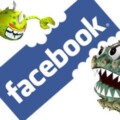
The Koobface Virus spreading through Facebook is catching Facebook users off-guard by deceiving them into clicking on a message that supposedly contains an embarrassing video of themselves. The message even appears to come from a Facebook friend. Listen to the audio below by Dale Powell about the 3 mistakes to avoid to prevent getting this type of infection, virus and spyware prevention tips can go a long way if “actually” implemented.
If you feel this information has helped you, please consider making a modest donation to help keep this website going.
DoubleMySpeed.com – CyberDefender Review
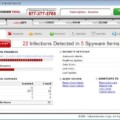
Many people have seen the popular DoubleMySpeed.com TV Commercial and can relate to the frustration of having a slow computer. But are the commercial’s claims true, that their software can actually double the speed of “your” computer?
Take a moment and listen to the DoubleMySpeed audio review by Dale Powell (aka the SpywarePreventionGuy) and decide for yourself.
The product they are offering is actually called CyberDefender, which you must know is NOT certified by ICSA Labs, WestCoast Labs, Virus Bulletin (VB100), or AV-Comparative virus testing and certification companies. All the major computer and internet security software companies such as Eset Nod32 (my favorite), Symantec and McAfee are all certified by these 4 companies. Their product also appears to be targeted at consumers instead of businesses. They do not offer any business enterprise security products.
You will also find out that they don’t list any prices on their www.doublemyspeed.com website, but they usually tailor their solution with a combination of products costing about $49.00 (and this seems to vary). You can get more information from their www.cyberdefender.com website. But if you call their customer service line for help, you will find that they are very motivated in up-selling their “Live Help Desk” product for $249.00.
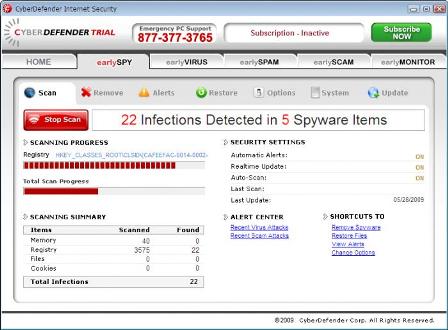
Many technicians will tell you that it takes several different reputable products to clean and tune-up the performance of a computer, not to mention manual procedures that only a live person can perform. Perform a search with your favorite search engine to find out actual customer experiences with CyberDefender, you will quickly develop an informed opinion on your own about whether you should purchase their software. You can also checkout the Ripoff Report to read about some CyberDefender experiences as well.
Below are some reputable alternatives to CyberDefender that I personally recommend and use regularly myself:
ESET Nod32 Antivirus: Free 30 Day Trial
SUPERAntiSpyware: Free 15 Day Trial
CCleaner: Freeware (Checkout my Free CCleaner Video Tutorial)
With all the competitively priced “certified” products on the market, please do your research first before taking a chance with your computer health and internet security. It might be hard to choose what you “will” use, but it will be easy to decide what you “won’t” use. I hope this review helps you to decide.
If you feel this information has helped you, please consider making a modest donation to help keep this website going.
Can Windows 7 Get Viruses?
Yes, Windows 7 gets chased by viruses and can in fact get both virus and malware infections! In fact, we have already started to have Windows 7 based computers carried into our shop for virus removal. The spyware prevention tips you have been learning for previous Windows versions still apply for Windows 7.
But in defense of Windows 7, I will have to say that these internet surfers either let their trial antivirus products expire, or they just practiced the same naive internet surfing habits we see no matter what operating system they use. In other words…it was preventable!
I have installed Windows 7 Ultimate on 3 of my computers so far and am more than satisfied. While I have heard of people having issues even upgrading, I’ll bet that they have some form of malware, application or driver incompatibility that they didn’t resolve before upgrading. Please run and heed the results from the Windows 7 Upgrade Advisor before actually upgrading. And by all means, don’t try to upgrade an infected computer!! It could prevent the upgrade from installing properly and you may just end up with a broken computer.
Moving on…Windows 7 boasts a much improved version of its built-in firewall, scaleable User Account Control, as well as Windows Defender for malware protection. If you have no or expired antivirus software, you might at least install Microsoft Security Essentials which is available for free from Microsoft. I haven’t seen enough computers using this product to form an opinion yet, but as I usually say, freeware usually only offers “basic protection”.
So although the threats are still out there, Windows 7 is a bit harder to infect and when it does get infected, I can say that it is much easier to disinfect than the same infection on a Windows XP computer. With that said, why not learn more about prevention. Use a Standard User account for your internet surfing, make sure you use multi-layered protection with top-tier antivirus and antispyware products, links scanners, and always do your homework before clicking that link.
How Did My Computer Get a Spyware Infection?

In my role as a computer grief counselor, I hear customer after customer cry out “How did I get infected, I’ve got “that antivirus program from the yellow box?” While I’m not going to make this article into a smear campaign about how I don’t like that antivirus program in the yellow box…or the red box for that matter, there are several other lesser known products that I see trojans get past on a daily basis. Keep reading and I’ll tell you the name of the antivirus product that we have come to know as the very best antivirus product available.

Virus FREE Computer
Most customers come in with a pretty good idea they have a virus infection. The truth is that only about 3% of the computers we see actually have a traditional virus. Usually it ends up being some form of malware, but not true viruses, but they will all probably make your computer very slow.
Spyware Prevention – Basic Introduction

Whether you use your computer for business or pleasure, if you surf the internet, I’ll bet that you have already been infected with some form of malware at one time or another such as: adware, bots, botnet , hoaxes, malware, payload, phishing, rootkits, scams, spyware, trojan horse, viruses, and worms. They are all unwanted software items that you absolutely do not want on your computer. You don’t even have to know all the technical names to avoid them. And just to keep things simple, most people have distilled these terms down to just “viruses and spyware”. We are not going to get into the technical differences other than to say that viruses replicate and spyware doesn’t.
So can we avoid them? Ever heard of abstinence? Just stay off the internet, stay off networks, and don’t insert and untrusted CDs, external hard drives or flash drives into your computer. That’s it! I just saved you hundreds and hundreds of dollars you would otherwise spend in the next couple years repairing your computer.

OK, so you wouldn’t even use the computer if you couldn’t surf the internet, and you use an external drive to save your files from work to bring home and work on them there. So lets find a happy compromise out of the usual spyware prevention tips in our favor where we can use our computer on the internet to the full.
We will clue you in on what we consider the very best antispyware and antivirus products, none of which have a high price tag. They are actually quite reasonable compared to what you have already been paying. Most of these tools are downloads and you probably won’t find them in a store. There will also be a few freeware tools to use as well, but the main course will be educational. It will focus on developing safe internet surfing habits, how to recognize potential malicious search engine results, malicious websites, their tactics and how to get out of a drive-by download.
We are confident you will be able to learn these techniques, even if you are a self-described computer illiterate. You probably know more than you realize anyway. We know this because we actually meet many of our customers in person at our shop in Hawaii.
So stay tuned for more exiting, powerful, spyware busting lessons. Some of which I would have to say would blow the whistle on our secrets of spyware removal that many of you may be able to do yourselves…for the most part. But know this, it takes a couple good years of removing spyware for a living to really do it thoroughly, to my standards anyway. But who gets off every water spot when washing their car, who gets an A on every test, who can draw a perfectly straight line…freehand. I think you get the point.
